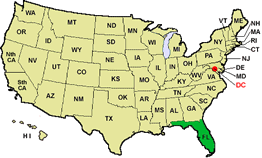| Tropical Smooth-headed drywood termites |
| Cryptotermes cavifrons |
Evening swarmers are attracted to lights. Night swarms usually contain dozens, occasionally hundreds of swarmers. They often fly directly into buildings structures and infest timber wood directly with out the need for soil. They typically first infest exposed wood such as window/door frames, trim, eaves, attics, etc. These places are typical points of entry since access is provided via man-made joints to allow the termite in. Some call the termites "lazy" because of their unwillingness to enter sides of exposed wood. When swarming, they usually re-infest the same structure. Multiple colonies are often found in a structure or single infestation site. Cryptotermes drywood termites live in wood that has fairly low moisture content and is not in contact with soil or any other moisture source. They must get their needed moisture from the wood they live in, so they are usually found in humid coastal or subtropical areas. They can be transported to other areas in infested furniture, picture frames, decorative wooden objects, or wood for construction. Colonies of these termites are relatively small (fewer than 3,000 individuals), and they increase slowly, requiring several years before any swarmers are produced. They do not build mud shelter tubes, which are typical of most species of subterranean termites. Their damage is usually localized, but quite a bit of damage can result from multiple colonies in one building or structure. Crypototermes drywood termites can be successfully eliminated by a variety of methods that would not be effective against subterranean species. Heating, freezing, microwaves, or high-voltage electric charges on or into all or a portion of the infested structure, or wooden objects, can kill off whole colonies. Drywood termites live in the wood where they feed. Colonies construct nests in the wood itself and they do not require soil-to-wood contact. Typically, drywood termite colonies are smaller and slower to develop than those of either dampwood or subterranean termites. Drywood termites construct large galleries, both across and with the wood grain and undermine the stability of timber, causing limbs or entire trees to fall or to become weakened. |
| About Termites in Your Local Area |
CLICK ON YOUR STATE: Alabama - Arizona - Arkansas - North California - South California - Colorado - Connecticut - Delaware - Florida - Georgia - Hawaii - Idaho - Illinois - Indiana - Iowa - Kansas - Kentucky - Louisiana - Maine - Maryland - Massachusetts - Michigan - Minnesota - Mississippi - Missouri - Montana - Nebraska - Nevada - New Hampshire - New Jersey - New Mexico - New York - North Carolina - North Dakota - Ohio - Oklahoma - Oregon - Pennsylvania - Rhode Island - South Carolina - South Dakota - Tennessee - Texas - Utah - Vermont - Virginia - Washington - Washington-DC - West Virginia - Wisconsin - Wyoming |
| Find out about latest termite control methods - Click here |
